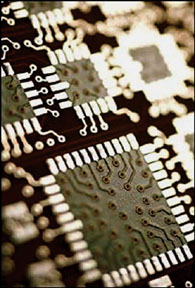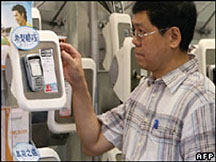|
observer |
|
|
|
|
|
OTHER LINKS |

|

|

|
Science & TechnologySpeedy silicon sets world record
"It just takes a standard technology and adds one extra step," said Professor Peter Ashburn at the University of Southampton, who carried out the work. "This is a really cheap method." Silicon sandwich The research was carried out using a simple type of transistor known as a silicon bipolar transistor. Transistors are the tiny building blocks of most microchips and millions are found in desktop computers, mobile phones and MP3 players. They are used to regulate electronic currents in microchips, and depending on the type may be used to amplify a signal or open and close a circuit. Combinations of transistors can be used to do calculations or useful computational work. Bipolar transistors are made of three layers of semi-conducting material arranged in a sandwich structure, with two layers of one material with a filling of a different sort. A thinner filling in the transistor means electrons can flow through the device more quickly, increasing the overall speed of a circuit or chip. Alternative approaches for building fast transistors exist but they use other materials, such as gallium arsenide or a silicon germanium mix, which require more expensive manufacturing techniques. The silicon industry would like to continue to squeeze greater speeds out of smaller chip using existing manufacturing processes which are cheap and reliable. The work from the University of Southampton offers one solution.
At an atomic level, the fluorine creates small clusters of vacancies, areas of missing silicon atoms. These voids suppress boron diffusion, creating a thinner layer and therefore speeding up the transistor. "It's atomic engineering really, even smaller than nanotechnology," said Professor Ashburn. World record When the researchers tested the new device it clocked a speed of 110 GHz. Complete circuits usually operate at about a tenth of the speed of the component transistors meaning the new devices could allow engineers to build chips that operate at a speed of about 11GHz. (BBC NEWS)Simple way to test for anthrax
The spate of US anthrax attacks in October 2001 highlighted the need for fast and reliable ways to diagnose of anthrax. Indeed a month later, US scientists developed a test that could confirm the presence of anthrax in just under an hour by analysing the genetic material of the bacteria. Prior to that it had taken days to confirm the presence of anthrax in human and environmental samples. But scientists have been looking at ways to test results even faster and have been investigating immune techniques to this end. Previous attempts at developing a fast anthrax tests using the same immunological technology as the new Swiss test failed because the targets used were not specific enough. The similarity of anthrax's surface to those of other bacteria found in humans had been a major stumbling block. Immunological tests work by detecting or quantifying a specific substance in a sample using an immunological reaction between things called antibodies and antigens, and can give results in minutes. (BBC NEWS)Cinema meets digital technology
Shooting on film may be expensive, but it has a special quality unrivalled by any other media, and though we are not necessarily aware of what is going on behind the scenes when we turn up at the box office, we are stepping into the world of 35mm film. The release prints of movies arrive in projection rooms as 10,000 feet of film printed as a copy of the original. So far the only sop towards digital in the analogue cinema world has been in the realm of sound. But now, finally, film itself may be facing the final curtain as cinemas find the pull of digital forces irresistible. Picture perfect Digital projection systems are the latest thing. The release copy of the movie is delivered on a hard drive, sporting 100 gigabytes of the latest Hollywood fare, a digitally scanned copy of the master film print. Once clipped into place the movie is simply uploaded to a server and is one button-push away from being digitally projected. The big advantage of digital projection is the picture quality. With film, every imperfection gets shown as the 35 mm print passes through the projector, including scratches, fluff, blotches and so forth; not exactly what the director intended for their creative vision. With a digital projector linked to a server there are no more stray hairs, scratches or dust - just a crystal clear picture. The rest of the entertainment world embraced digital years ago, so why are the cinemas so late to the party? "It's taken so long because it's been a question of agreeing in advance," said David Hancock of Screen Digest. "It's been a consensus building process, which started in 1999 with the first commercial release of Star Wars Episode One. "Since then we've had five years of testing the technology, building a consensus and agreeing the business models and technology to be used, and this took longer than most people expected." Big savings Now the industry has reached a watershed, and digital cinema is about to take off in a big way. A couple of years ago there were only 335 digitally-equipped screens worldwide. By the end of last year, in which Hollywood finally published a common technical standard, that number had almost trebled, to 849 screens. Forecasts predict 17,000 screens in just a few years from now, concentrated in the movie world's spiritual home, the US. The Hollywood studios are driving this transition because they stand to make enormous savings, which they can pass on to the cinemas themselves. The most obvious saving is in distribution costs. An average length feature film print costs around o700 ($1,300). Encoding it and delivering a hard drive to the cinema works out at a fraction of that. In future, the possibility of delivering the movie by satellite or over the net has got the bean counters salivating. One of the other great costs to the movie industry is piracy, which Hollywood claims has cost it $6bn (o3.2bn). Distributing movies digitally means they can be encrypted before they even leave the studios, and then unlocked by software at the cinemas themselves. Tinseltown's films could get more showings, too. Digital movies can be streamed from the server to different screens at the same time; or alternatively a variety of movies can be shown on the same screen throughout the course of a day. (BBC NEWS)Agency approves first use of viruses as a food additiveA mix of bacteria-killing viruses may be sprayed on cold cuts, wieners and sausages to combat common microbes that kill hundreds of people a year, federal health officials ruled Friday. The ruling, by the Food and Drug Administration, is the first approval of viruses as a food additive, said Andrew Zajac of the Office of Food Additive Safety at the agency. Treatments that use bacteriophages to attack harmful bacteria have been a part of folk medicine for hundreds of years in India and for decades in the former Soviet Union.The approved mix of six viruses is intended to be sprayed onto ready-to-eat meat and poultry products, including sliced ham and turkey, said John Vazzana, the president and chief executive of Intralytix, which developed the additive. The viruses, called bacteriophages, are meant to kill strains of the Listeria monocytogenes bacterium, the food agency said. The bacterium can cause a serious infection called listeriosis, primarily in pregnant women, newborns and adults with weakened immune systems. In the United States, an estimated 2,500 people become seriously ill with listeriosis each year, according to the federal Centers for Disease Control and Prevention. Of those, 500 die. Luncheon meats are particularly vulnerable to Listeria because after they are bought they are typically not cooked or reheated, which can kill harmful bacteria like Listeria, Mr. Zajac said. The preparation of bacteriophages - the name is from the Greek for "bacteria eater" - attacks only strains of the Listeria bacterium and not human or plant cells, the food agency said."As long as it used in accordance with the regulations, we have concluded it's safe," Mr. Zajac said.People normally come into contact with bacteriophages through food, water and the environment, and they are found in our digestive tracts, the agency said. (AP) |
 A simple tweak to the way common silicon transistors are made could
allow faster, cheaper mobile phones and digital cameras, say UK
researchers. Devices with the modification have already set a new world
record for the fastest transistor of its type. To achieve the speed
gain, researchers at the University of Southampton added fluorine to the
silicon devices. The technique uses existing silicon manufacturing
technology meaning it should be quick and easy to deploy.
A simple tweak to the way common silicon transistors are made could
allow faster, cheaper mobile phones and digital cameras, say UK
researchers. Devices with the modification have already set a new world
record for the fastest transistor of its type. To achieve the speed
gain, researchers at the University of Southampton added fluorine to the
silicon devices. The technique uses existing silicon manufacturing
technology meaning it should be quick and easy to deploy.  Professor Ashburn and colleagues at STC Microelectronics used a
simple transistor made of silicon with a boron filling for the research.
To make transistors of this type requires high temperature manufacturing
processes which cause the boron layer to diffuse, creating a thicker and
hence slower layer. To get round this problem, the researchers added
fluorine implants to the silicon layers using a common manufacturing
process, known as ion implantation. Ion implantation involves firing
atoms of one element, in this case fluorine, at a target of silicon.
Professor Ashburn and colleagues at STC Microelectronics used a
simple transistor made of silicon with a boron filling for the research.
To make transistors of this type requires high temperature manufacturing
processes which cause the boron layer to diffuse, creating a thicker and
hence slower layer. To get round this problem, the researchers added
fluorine implants to the silicon layers using a common manufacturing
process, known as ion implantation. Ion implantation involves firing
atoms of one element, in this case fluorine, at a target of silicon.  Swiss scientists say they have found a fast and simple way to test
for deadly anthrax. Diagnostic tests already exist but are expensive and
time-consuming - and time is critical since anthrax infection can kill
unless treated within 24 hours. The new test targets a molecule unique
to anthrax, which is found on its surface, to give a result in minutes
rather than days or hours. The work by the team at Bern University is
published in Angewandte Chemie.
Swiss scientists say they have found a fast and simple way to test
for deadly anthrax. Diagnostic tests already exist but are expensive and
time-consuming - and time is critical since anthrax infection can kill
unless treated within 24 hours. The new test targets a molecule unique
to anthrax, which is found on its surface, to give a result in minutes
rather than days or hours. The work by the team at Bern University is
published in Angewandte Chemie.  Filmmakers have relied on film to make their movies for almost as
long as the industry's been around.
Filmmakers have relied on film to make their movies for almost as
long as the industry's been around. 







